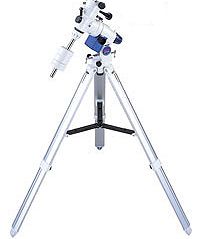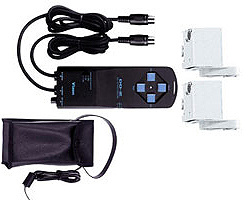Vixen GPD2 German Equatorial Mount, HAL130 Tripod and D2M Motor Drive Set By the Astronomy and Photography Online Staff  Vixen GPD2 mount w/HAL130 tripod and motor set. Photo courtesy of Vixen Optical. The Vixen GPD2 German Equatorial mount evolved from Vixen's earlier Polaris, Super Polaris and Great Polaris mounts. It is the biggest and strongest of the Vixen Great Polaris series mounts. GPD2 mounts are sold separately and are also available packaged with various Vixen telescopes ranging from the ED81s (a 3.2", 7.5 lb. APO refractor) to the mighty NA140SSf (5.5", 14.3 lb. APO refractor). That is a good indication of the size and weight range of telescopes with which the GPD2 mount is most comfortable. It is what we would call a medium size German equatorial mount. It can carry telescopes weighing up to about 25 pounds, depending on physical length and focal length, with very good damping and stability. Standard equipment includes two counterweights weighing four pounds and eight pounds. A polar axis alignment scope and a built-in illuminator is also included in the 2009 MSRP of $1099 for the GPD2 mount head. Order the basic GPD2 mount with a HAL130 heavy-duty tripod and the price for the set is $1299. The high zoot package includes both of the above plus the D2M Motor Set for $2199. Our test mount was supplied with the D2M Motor Set, complete with #3828 Manual Clutches on both axis. This manual clutch restores the functionality of the slow motion controls when the MT-1 motor is installed on the GP or GPD2 mount. The clutch has a knob that disengages the motor so that the manual control is active. Once the desired adjustments are made, the motors can be re-engaged by turning the knob. This is a very desirable option and well worth the extra $39.95 per clutch. We also requested a #5460 Triangle Accessory Tray ($29.95) for the tripod and a #8800 11.5" Flex Handle ($24.95) for the GPD2's manual declination (DEC) slow motion control shaft, bringing the 2009 MSRP for our GPD2 mounting system, as tested, to $2333.80. For the purposes of this review, our GPD2 was paired with a Stellarvue SV115T APO refractor weighing about 17 pounds with rings, Vixen mounting rail, finders (it has three) and visual accessories. This telescope is about 36" long with visual accessories. (You will find our review of the SV115T on the Astronomy and Photography Online index page.) Vixen's GPD2 boasts solid steel RA and Dec axis shafts. Its brass worm gears are very precisely machined to 2/1000'ths of a millimeter to minimize periodic error. These mounts undergo 100% inspection and function testing of the drive gears. As Vixen promotional literature states, "You can rest assured that when you purchase a GPD2 it is going to work right out of the box." GPD2 mounts can be purchased direct from Vixen (www.vixenoptics.com) or from online retailers, such as Optics Planet (www.opticsplanet.com). Technical data GPD2 Mount
Technical data HAL130 Tripod
Technical data D2M Motor Drive Set
The GPD2 mount head is designed to accept Vixen type, quick-release, dovetail mount rails. The Vixen rail is secured in place by a bolt with a large finger knob and there is a smaller, secondary bolt to prevent the scope from sliding out of the mount should the main bolt loosen. It is a good system. The illuminated polar axis scope has an alignment reticle for both the Northern and Southern hemisphere. It aims through the center of the mount and allows very accurate polar alignment, excellent for astrophotographers. For visual use in the Northern hemisphere it is unnecessary if you have correctly set the mount for the latitude of your observing site, leveled the tripod and pointed the north leg of the tripod at the North Star. That simple procedure will align the mount close enough for visual observation and star hopping. It is easy to assemble a GPD2 on the HAL130 or break it down for travel. To take the mount apart, first slew the mount so that the telescope is centered over the mount and tripod. Remove the telescope from the mount using the Vixen quick release system. Disconnect the cords from the motor drives (if present). Remove the counterweight shaft stop screw and slide the counter weight off the shaft. (Replace the stop screw so you do not lose it.) Removing the counterweight shaft is not necessary, but if you choose to do so, it makes the mount head more compact to pack. The �" diameter weight shaft simply unscrews from the mount head, where it is secured by a large hand nut. Back off the azimuth adjusting finger screws at the front of the mount about a turn to create a little slack. The GPD2 mount head sits in a 2-5/16" diameter socket on top of the HAL130 tripod and is held in place by a center under-bolt that is tightened by a finger knob. Unscrew the bolt holding the mount head to the HAL130 tripod and lift off the head. Remove the accessory tray (if present). Fold the tripod legs and you're finished. The main pieces are the tripod legs, mount head, counterweight shaft (if you unscrewed it from the mount head) and counterweight, none of which are overly heavy. The GPD2 mount head itself is the heaviest part and it weighs 18.7 pounds. Reassemble in reverse order. A GPD2 on a HAL130 tripod is a sturdy mounting system that quickly dampens minor vibrations when used with appropriate telescopes. The GPD2 worked very well with our 4.5"/800mm Stellarvue SV115T APO test telescope and would probably be sufficient for typical achromatic refractors up to about 6"/1000mm. You can lightly touch the mount or focus the telescope without the image dissolving into jiggle blur, something that cannot be said for inferior mounts. The GPD2 is similar to the Losmandy GM8 in this respect, which is to say very good for its size and weight. Slewing a GPD2 manually is a smooth operation. It is easy to point a properly balanced telescope at any part of the sky. Set the RA and Dec paddle locks and fine aiming adjustments can be made using the manual slow-motion controls. These come with a short knob for the RA shaft and a knob with a 5.5" shaft for the DEC shaft, but optional, 11.5" flexible metal stalks with large plastic knobs are available. We found that the standard short knob worked best on the RA shaft and a long stalk to be convenient on the DEC shaft. The latter put the manual DEC slow motion control near the telescope's focuser, where it was close at hand. The slow motion controls work efficiently with little take-up and allow an object to be precisely centered in even the highest magnification eyepiece. If the D2M Motor Drive Set is installed, and installation is simple, the included DD2 hand controller is normally used to slew the mount and aim the telescope. Alternatively, if manual clutches have been installed along with the drive motors, you can revert to using the manual slow motion controls at any time. For visual observing, a motorized EQ mount is not necessary. It is easy to keep objects in the field of view using just the RA slow motion control. If you do your tracking manually, you are not battery dependent. However, if more than one person is to use the telescope, the D2M Motor Drive Set is a convenience. It is supplied with RA and DEC motors, a battery pack that holds eight "D" cell batteries, all connecting cords and a four-way, three-speed hand controller. The cords from the hand controller to the motors terminate in multi-pin DIN plugs, while the power cord from the battery pack plugs into the hand controller by means of a small coaxial plug. The basic tracking speed is sidereal, with 1.5x, 2x and 32x sidereal rate slewing speeds. The general movement speed is 32x; the 1.5x and 2x speeds are used for precise guiding during astrophotography. We generally prefer to adjust declination manually, so we usually only plug-in the RA motor. This eliminates one of the two motor connecting cords. We keep the DEC motor cord neatly bundled and zip-tied, simplifying hook-up and leaving one less thing to snag in the dark. The D2M Motor Drive Set works well and the battery life is good. It is excellent for keeping the subject in the field of view at star parties, where several people are sharing views through each other's telescopes. Conclusion The Vixen GPD2 is a high quality German equatorial mount. It is a capable mount that can handle serious astronomical telescopes of various types and configurations. It is easy to use and functions well for both the visual observer and astrophotographer. For a large refractor, such as our SV115T test scope, it is a better choice than the smaller Vixen GP2 mount. Although we did not have a Celestron C8 on hand for this review, we are quite familiar with the scope and estimate that the GPD2 would be a good mounting choice for this 8"/2032mm CAT with its 12.5 pound optical tube. A C8 is very similar in size to the Vixen VMC200L (an 8"/1950mm, 13.2 lb. CAT), which is available bundled with the GPD2 mount, so the combination should work well. The C8-A XLT optical tube (item #91020-XLT) comes with a full-length Vixen mounting rail, ready to drop onto a Celestron CG-5 or Vixen GPD2 mount, and we prefer the GPD2. These catadioptric scopes are a stern test for a mount, because of their long focal length and consequent high magnification capability. We estimate that the GPD2 should also serve quite nicely for physically longer Newtonian reflectors up to about 8"/1250mm. The GPD2 is particularly attractive to those who prefer not to rely on battery power for their viewing pleasure, an advantage the GPD2 maintains over its Celestron CGEM (computerized go-to) and Losmandy GM 8 (internally motorized) mount competition. It has manual slow motion controls and does not require motors to operate correctly. Single or dual axis motor drives are available as accessories, of course, as is the Star Book-S go-to computer system for those who want it. Vixen's marketing philosophy allows the customer to buy as basic or as sophisticated a GPD2 mount system as he or she requires. Of course, all of this quality and versatility come at a price, which in the case of the GPD2 is considerable if you buy all of the available optional extras. If you stick with the basic GPD2 mount and HAL130 tripod, its price is similar to its Celestron and Losmandy competition. It is perhaps most comparable in price and performance to a Losmandy GM 8 plus LW tripod. (A review of that mounting system can be found on the Astronomy and Photography Online index page). The primary difference between the two, from a potential purchaser's standpoint, is that the Vixen GPD2 comes with excellent manual slow motion controls and a polar finder scope, but drive motors are an extra cost option. The Losmandy GM8 comes with dual axis motors and a polar finder scope is available as an extra cost option, but it completely lacks manual slow motion controls and there is no provision to add them. The two mounts' carrying capacities are similar, so functionally it comes down to a question of "batteries or no batteries, hand or hand controller?" Astronomy and Photography Online Senior Editor Gordon Landers uses a Losmandy GM 8 and Managing Editor Chuck Hawks is keeping the GPD2 for his personal use, so a head-to-head comparison article is probably in the offing. Stay tuned to Astronomy and Photography Online for further details . . .. |


